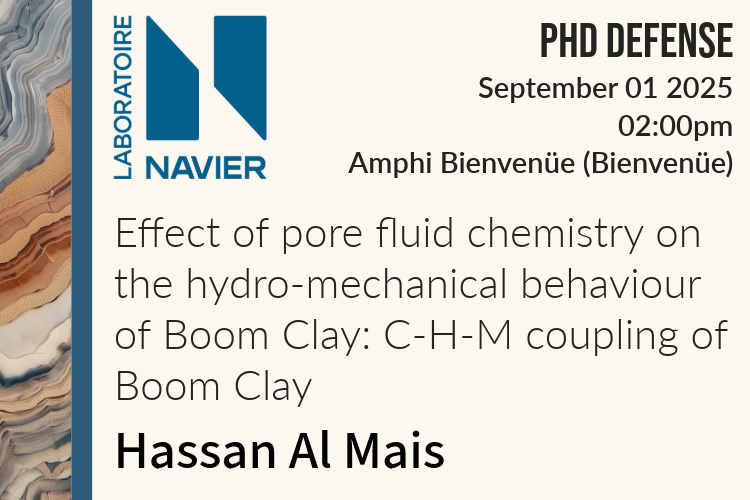
PhD Defense – Hassan Al Mais
- Post by: Mathias Lebihain
- 20 August 2025
- No Comment
Hassan Al Mais, a PhD candidate in the Geotechnics team, will defend his dissertation titled “Effect of pore fluid chemistry on the hydro-mechanical behaviour of Boom Clay: C-H-M coupling of Boom Clay" on Monday, September 1st, at 2:00 PM, in the Bienvenüe amphitheater.
Composition of the jury:
- Prof. Olivier CUISINNIER (Université de Lorraine) – Reviewer
- Prof. Jian-Fu SHAO (Université de Lille) – Reviewer
- Prof. Anne-Catherine DIEUDONNÉ (TU Delft) – Examiner
- Prof. Bertrand FRANÇOIS (Université de Liège) – Examiner
- Dr. Séverine LEVASSEUR (ONDRAF/NIRAS) – Examiner
- Dr. Elie VALCKE (SCK CEN) – Examiner
- Prof. Yu-Jun CUI (École des Ponts ParisTech) – Supervisor
- Prof. Frédéric COLLIN (Université de Liège) – Co-supervisor
- Dr. Temenuga GEORGIEVA (EURIDICE) – Co-supervisor
- Dr. Suresh SEETHARAM (SCK CEN) – Co-supervisor
The defense will be broadcasted live on Microsoft Teams. You can follow it here: Teams Link
Abstract
Show the abstract
Deep geological disposal is one of the technological options for the long-term management of radioactive waste by isolating harmful radionuclides from the biosphere through a system of engineered and geological barriers. In Belgium, Boom Clay is considered a reference host formation due to its low permeability, high retention capacity, self-sealing behavior, and favorable mechanical properties. Among the waste forms intended for disposal, Eurobitum waste, produced by bituminization of reprocessing effluents, contains high concentrations of (Na,Ca)NO3. Under repository conditions, the bitumen matrix gradually absorbs water and swells, resulting in the progressive release of the embedded salts that diffuse into the surrounding clay formation. This hypersaline plume induces chemical perturbations that can affect the hydro-mechanical behavior of Boom Clay by altering its microstructure, swelling capacity, and strength.
This thesis presents an investigation of the influence of salinity (Ionic Strengths: 0.015 M, 1.0 M, and 2.0 M) and sodium occupancy (60% and 90%) on the hydro-mechanical behavior of Boom Clay by combining a dedicated experimental campaign with the development of a chemo-mechanical constitutive modeling approach. The experimental program includes swelling pressure measurements under constant-volume conditions, salinization and desalinization tests under oedometric conditions, high-pressure oedometric tests, undrained shear strength tests, and microstructural analyses using mercury intrusion porosimetry. The results demonstrate that increasing salinity leads to a reduction in swelling pressure, an increase in shear strength, and modifications of the aggregate structure, especially at high ionic strengths, which also result in increased hydraulic conductivity. While the observed effects of ionic strength are qualitatively consistent with findings reported for other clay materials, the study provides new insights into the role of sodium occupancy—particularly its potential influence on interlayer spacing—in shaping the chemo-hydro-mechanical response of Boom Clay.
To interpret and predict these coupled effects, a chemo-mechanical constitutive model named ACC2-Chem was developed. The starting point was the ACC-2 elasto-plastic model, initially formulated under in-situ pore water conditions (Ionic Strength = 0.015 M), by introducing a cohesion parameter into both the yield surface and the plastic flow rule to better represent the mechanical response of Boom Clay. In parallel, a new chemo-elastic volumetric strain model was developed to describe the elastic deformations induced by changes in ionic strength and sodium occupancy. This chemo-elastic model was then coupled with ACC-2, resulting in the integrated ACC2-Chem model that captures the chemo-hydro-mechanical interactions in Boom Clay. The model was implemented in the finite element code LAGAMINE and calibrated using set of laboratory data. Its validity was verified by reproducing the main trends observed in salinization/desalinization and triaxial tests at the laboratory scale.
Finally, 2D repository-scale simulations were conducted to evaluate the long-term chemo-hydro-mechanical behavior of Boom Clay under high salinity perturbations using a decoupled approach. The simulations capture the phenomenological evolution of the repository through four sequential phases: (1) an initial excavation phase lasting one day, (2) a 100-year operational phase under drained conditions, (3) a 300-year post-operational equilibrium phase, and (4) a 500-year swelling and/or diffusion phase simulating long-term interactions between Eurobitum waste and Boom Clay.
The above findings have contributed to the current understanding of the behavior of Boom Clay under short term exposure to chemically perturbed environments, and has provided theoretical underpinning for a mathematical framework that may support safety and performance assessments for the geological disposal of bituminized radioactive waste in Belgium.


